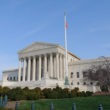On March 16, 2016, President Barack Obama nominated Federal Appeals Court Judge Merrick Garland to replace the late Justice Antonin Scalia on the Supreme Court. And nearly 13 months later, on April 7, 2017, the Senate confirmed President Donald Trump’s pick, Federal Appeals Court Judge Neil Gorsuch, to take Scalia’s seat. The extraordinary events of the 387-day standoff in between won’t just shape the Court for decades to come. It won’t just redefine the relationship between the Senate and presidents in the years ahead. It will shape the course of American history for generations. In fact, as the first year of the Trump presidency winds down, you could argue it already has.
One way to view the Supreme Court in 2017 is to see the year, and the two court terms that bookended it, as a sort of entr’acte following the end of the Scalia era and the beginning of the Gorsuch era—an intermission, a rare pause in history, between what was and what is to be. We now have reason to know that Justice Gorsuch will vote to the right of Justice Scalia in some instances and that the Court will remain as rigidly conservative as it was before. We have, still, the most conservative court in 75 years, marked occasionally by brief spasms of moderation from Justice Anthony Kennedy or, even more rarely, from Chief Justice John Roberts.
Another way to view the Supreme Court in 2017 is to imagine it as a pendulum at rest. This is apt not just because the Court was split evenly along ideological lines 4–4 after Justice Scalia died suddenly and before Gorsuch was confirmed. It also is apt because there was every reason to believe, when Scalia died during the last year of the Obama administration, that the Court would lose the conservative majority it has held for nearly 50 years. No reasonable court-watcher disputes the notion that Merrick Garland, who in a more rational age would have been confirmed with bipartisan support, would have moved the Court toward a moderate centrist position.
The year 2017 marked the end of Supreme Court nominations as we have known them.
But the pendulum never swung back left, as it was supposed to do, because of the cheap trick pulled by Senate Majority Leader Mitch McConnell and his fellow Republicans. Their refusal to bring the Garland nomination to a vote—some Republican senators even refused to meet with the nominee, much less give him a confirmation hearing—ensured, in the end, that the pendulum would reverse itself, against the laws of history and precedent, and guarantee a few more years, and perhaps more, of conservative control of the Court. Justice Gorsuch’s nomination, along partisan lines, was the story of the year at the Supreme Court not just because of what it means for future cases, but because it vindicated the Republicans’ cynical ploy. The year 2017 marked the end of Supreme Court nominations as we have known them.
***
So Gorsuch became the newest justice, beloved by the conservatives who endorsed him and scorned by progressives, who say he is an illegitimate justice. He arrived at the Court in time for the final oral arguments of the 2016–2017 term and immediately generated a reputation for seeming to annoy his older and established colleagues with the pace and tone of his questions.
More significantly, Justice Gorsuch, in his first year on the Court, seems to underappreciate the gravity of concerns that all judges should have, and Supreme Court justices especially, over the avoidance of even the appearance of conflicts of interest.
As Jeffrey Toobin chronicled in The New Yorker a few months ago, for example, Justice Gorsuch gave a speech at the Trump International Hotel, at a time when the Court may have to rule on the Trump administration’s evident disregard for the Emoluments Clause of the Constitution. The clause arguably prohibits the president and his family from profiting from a business whose customers are foreigners who may also conduct business with the U.S. government.
Of the 2016–2017 term itself, which ended in June, there isn’t much else to say beyond what Adam Liptak of The New York Times wrote in his annual review. A court with only eight justices, four on each side of the ideological divide, generated “a modern record for consensus,” mostly because the justices either accepted fewer contentious cases for review or chose in the contentious cases it did review to issue limited rulings. Take, for example, the case of Gavin Grimm, the transgender teenager in Virginia who challenged his school board’s bathroom policy. The Supreme Court was cued up to take the case, and perhaps to uphold a lower court ruling in the boy’s favor through a 4–4 vote, until the Trump administration gave the Court’s conservatives a way out by reversing the Obama-era guidance supporting transgender rights. “Having eight was unusual and awkward,” Justice Samuel Alito said, immediately after the term ended, and he was right.
***
Now, as the year ends and the 2017–2018 term heats up with its most hotly debated and momentous oral arguments, we are beginning to see not just the fruits of the labor of McConnell and company but also the wreckage it has wrought. For example, the third version of the Trump administration’s travel ban, limited as it is from earlier versions and buttressed by a more thorough bureaucratic process, almost surely will be endorsed by the Court next year as a legitimate exercise of the president’s constitutional power over refugees and immigrants. The ruling, when it comes, won’t affirmatively endorse the racial and religious animus that we all know motivated the ban. But it won’t have to.
The administration’s lawyers, if not the president himself, seem to have figured out how to cover their discriminatory policies, at least enough to find safe harbor in the Constitution, if not in the court of public opinion. Clearly, no one in the administration is capable of preventing the president from sabotaging his own policies through his unhinged tweets. But the Feds keep telling the courts, Pay no attention to the man behind the curtain; pay attention instead to how we’ve fixed the flaws that once existed in these bans. First Team Trump limited the scope of the bans from version 1.0 to 2.0 to 3.0. Then the Feds trimmed up the current version with enough bureaucratic process to reassure the judiciary that the ban is no longer just some arbitrary and capricious directive from on high.
The travel ban looks mostly outward, toward men and women and children trying to make it to our shores. And even the Court’s progressives are likely to defer in one fashion or another to what the administration is trying to achieve. But the Court is poised to radically alter settled legal principles here at home, the way it would have were Justice Scalia still alive and scowling. It’s dangerous to play counterfactual games with the Supreme Court because the closest cases often generate surprising results. Who would have predicted that the chief justice would switch his vote to save the Affordable Care Act toward the end of the Court’s 2012 term? But on the issue of public employee unions, there is no mystery about what the Court is about to do or the role Justice Gorsuch will play in doing it.
The Court’s conservatives were poised before the death of Justice Scalia to strike down rules that allow public unions to collect “fair share fees” from nonmembers who also benefit from the gains of collective bargaining. Losing the ability to collect these dues would significantly harm the political and economic power of the unions. Justice Alito, in particular, has had it in for this rule and these unions for years, a reflection of his ardently pro-business jurisprudence. Two terms ago, the Court had a case teed up, a case that would have killed those “fees,” but then Justice Scalia died. And with him died that fifth vote to gut unions. The conservatives lost their majority but couldn’t shake the case. So when the challenge came last term to the justices, before Justice Gorsuch was on board, it ended in a tie, 4–4, and that left a lower court’s pro-union ruling intact.
Now, in Justice Gorsuch, another ardent foe of unions and dear friend of big business, that precious fifth anti-union vote has been found. And not just found but found with the explicit endorsement of an administration that, in contrast to its predecessor, is fully devoted to the idea of destroying the power of unions through right-to-work laws. So go out today and bet your rent money on the Court striking down this union-fee rule. And do so knowing there is no way that Justice Merrick Garland would have allowed it to happen. The diminution of union power is precisely the sort of economic rollback McConnell, the Federalist Society, and the Trump administration’s donor class had in mind when they refused to allow Garland onto the Court and then backed their man, Gorsuch.
With all the speculation around Gorsuch, it has been easy to overlook the one justice who almost always determines the close cases and surely will do so again in the coming months. Pick your theme. Yes, it was the “Gorsuch Court” in 2017, as we all looked for the ways in which he differentiates himself from the man he replaced. It will be the Gorsuch Court for a few days again, if and when he sides with a criminal defendant in the big Fourth Amendment case of the term, involving the growing police use in criminal investigations of cell site records culled from warrantless searches.
It was also the Roberts Court in 2017, as we watched the chief justice try to maneuver through the ramifications of an eight-member court split evenly along partisan lines. But in the end, it is still, for now anyway, the Kennedy Court, as it has been since the retirement of Justice Sandra Day O’Connor in 2005. (That a conservative judge like Kennedy, an appointee of President Ronald Reagan who voted to gut the Voting Rights Act as well as campaign finance reform, would be considered a “moderate” or “centrist” tells you what you need to know about how far this court has moved to the right over the past 40 years.) Justices Alito and Gorsuch and Clarence Thomas won’t get to kill public unions without Justice Kennedy’s vote. And his vote will almost certainly decide the other landmark case the current term brings us.
Masterpiece Cakeshop v. Colorado Civil Rights Commission, as everyone now knows, is not just a case about a wedding cake and an earnest baker. It’s a case that marks the next phase in a struggle between secularism and religion in American life. On the one hand, you have Jack Phillips, a baker who says his cakes are “art,” the creation of which establishes for him a First Amendment right to refuse to serve gay couples seeking to have people eat his cake at their same-sex weddings. On the other hand, you have anti-discrimination laws in Colorado and elsewhere that are designed to ensure that public business owners like Phillips cannot discriminate against any of their customers based on race, religion, or sexual orientation. The question in the case, at its essence, is whether the Court is going to allow people to use religion as an excuse to discriminate against other people.
Remember that rent money I told you to bet on the public unions case? Take your proceeds and parlay them into a bet that Justice Kennedy will write the ruling in the Colorado bakery case. His questions and comments in the oral argument in the case, in early December, worried those who believe that a “religious liberty” exemption to anti-discrimination laws will swallow those laws and then jeopardize other government rules and regulations that arguably could raise religious objections. I am less alarmed. Justice Kennedy is responsible for the legalization of same-sex marriage across America, and it is hard to believe that he is going to undermine the ramifications of that right just a few years later, in this case. It’s far more likely, in my view, that he will gin up a compromise the Court’s progressives can endorse that recognizes the earnestness of religious beliefs about same-sex marriage but discourages religious discrimination based on sexual orientation. In other words, that Justice Kennedy would destroy his own legacy on the Court is just too hard to fathom.
The entr’acte we know as 2017 is over. A stridently new conservative era has emerged. Merrick Garland is sadly a footnote in history. By hook or by crook, the Republicans, the party that always cares more about the federal judiciary than do the Democrats, have stolen control of the Supreme Court and will have it for years and perhaps for generations to come. It’s the Roberts Court. It’s the Gorsuch Court. It’s the Kennedy Court. What we don’t know, as 2017 ends, is whether it also is a Court whose justices will stand up bravely to the authoritarianism of Donald Trump, if and when they are confronted with it this new year. The fact that this is an open question tells us how much we need this Court and need it to be strong for the storm ahead, no matter what we think of the flaws and predilections of each justice.
Andrew Cohen is a senior editor at the Marshall Project, a fellow at the Brennan Center for Justice, and a senior legal analyst with CBS Radio News.






0 Comments